H. ATM Case Study Code
H.1 ATM Case Study Implementation
This appendix contains the complete working implementation of the ATM system that we designed in the Software Engineering Case Study sections found at the ends of Chapters 3–8 and 10. The implementation comprises 670 lines of Java code. We consider the classes in the order in which we identified them in Section 3.9:
• ATM
• Screen
• Keypad
• CashDispenser
• DepositSlot
• Account
• BankDatabase
• Transaction
• BalanceInquiry
• Withdrawal
• Deposit
We apply the guidelines discussed in Section 8.18 and Section 10.8 to code these classes based on how we modeled them in the UML class diagrams of Figs. 10.19 and 10.20. To develop the bodies of class methods, we refer to the activity diagrams presented in Section 5.9 and the communication and sequence diagrams presented in Section 7.13. Note that our ATM design does not specify all the program logic and may not specify all the attributes and operations required to complete the ATM implementation. This is a normal part of the object-oriented design process. As we implement the system, we complete the program logic and add attributes and behaviors as necessary to construct the ATM system specified by the requirements document in Section 2.8.
We conclude the discussion by presenting a Java application (ATMCaseStudy) that starts the ATM and puts the other classes in the system in use. Recall that we are developing a first version of the ATM system that runs on a personal computer and uses the computer’s keyboard and monitor to approximate the ATM’s keypad and screen. We also only simulate the actions of the ATM’s cash dispenser and deposit slot. We attempt to implement the system, however, so that real hardware versions of these devices could be integrated without significant changes in the code.
H.2 Class ATM
Class ATM (Fig. H.1) represents the ATM as a whole. Lines 6–12 implement the class’s attributes. We determine all but one of these attributes from the UML class diagrams of Figs. 10.19 and 10.20. Note that we implement the UML Boolean attribute userAuthenticated in Fig. 10.20 as a boolean attribute in Java (line 6). Line 7 declares an attribute not found in our UML design—an int attribute currentAccountNumber that keeps track of the account number of the current authenticated user. We’ll soon see how the class uses this attribute. Lines 8–12 declare reference-type attributes corresponding to the ATM class’s associations modeled in the class diagram of Fig. 10.19. These attributes allow the ATM to access its parts (i.e., its Screen, Keypad, CashDispenser and DepositSlot) and interact with the bank’s account information database (i.e., a BankDatabase object).
Fig. H.1. Class ATM represents the ATM.
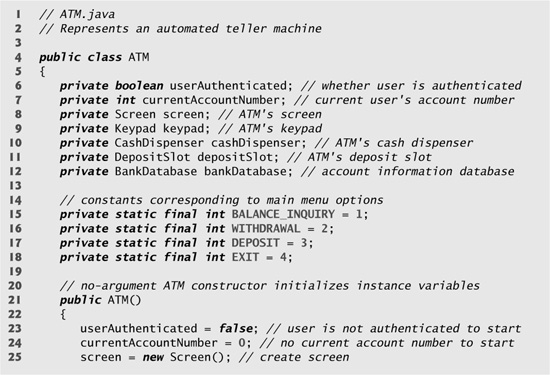



Lines 15–18 declare integer constants that correspond to the four options in the ATM’s main menu (i.e., balance inquiry, withdrawal, deposit and exit). Lines 21–30 declare class ATM’s constructor, which initializes the class’s attributes. When an ATM object is first created, no user is authenticated, so line 23 initializes userAuthenticated to false. Likewise, line 24 initializes currentAccountNumber to 0 because there is no current user yet. Lines 25–28 instantiate new objects to represent the parts of the ATM. Recall that class ATM has composition relationships with classes Screen, Keypad, CashDispenser and DepositSlot, so class ATM is responsible for their creation. Line 29 creates a new BankDatabase. [Note: If this were a real ATM system, the ATM class would receive a reference to an existing database object created by the bank. However, in this implementation we are only simulating the bank’s database, so class ATM creates the BankDatabase object with which it interacts.]
The class diagram of Fig. 10.20 does not list any operations for class ATM. We now implement one operation (i.e., public method) in class ATM that allows an external client of the class (i.e., class ATMCaseStudy) to tell the ATM to run. ATM method run (lines 33–50) uses an infinite loop (lines 36–49) to repeatedly welcome a user, attempt to authenticate the user and, if authentication succeeds, allow the user to perform transactions. After an authenticated user performs the desired transactions and chooses to exit, the ATM resets itself, displays a goodbye message to the user and restarts the process. We use an infinite loop here to simulate the fact that an ATM appears to run continuously until the bank turns it off (an action beyond the user’s control). An ATM user has the option to exit the system, but does not have the ability to turn off the ATM completely.
Inside method run’s infinite loop, lines 39–43 cause the ATM to repeatedly welcome and attempt to authenticate the user as long as the user has not been authenticated (i.e., !userAuthenticated is true). Line 41 invokes method displayMessageLine of the ATM’s screen to display a welcome message. Like Screen method displayMessage designed in the case study, method displayMessageLine (declared in lines 13–16 of Fig. H.2) displays a message to the user, but this method also outputs a newline after displaying the message. We have added this method during implementation to give class Screen’s clients more control over the placement of displayed messages. Line 42 invokes class ATM's private utility method authenticateUser (declared in lines 53–72) to attempt to authenticate the user.
Fig. H.2. Class Screen represents the screen of the ATM.

We refer to the requirements document to determine the steps necessary to authenticate the user before allowing transactions to occur. Line 55 of method authenticateUser invokes method displayMessage of the ATM’s screen to prompt the user to enter an account number. Line 56 invokes method getInput of the ATM’s keypad to obtain the user’s input, then stores the integer value entered by the user in a local variable accountNumber. Method authenticateUser next prompts the user to enter a PIN (line 57), and stores the PIN input by the user in a local variable pin (line 58). Next, lines 61–62 attempt to authenticate the user by passing the accountNumber and pin entered by the user to the bankDatabase’s authenticateUser method. Class ATM sets its userAuthenticated attribute to the boolean value returned by this method—userAuthenticated becomes true if authentication succeeds (i.e., accountNumber and pin match those of an existing Account in bankDatabase) and remains false otherwise. If userAuthenticated is true, line 67 saves the account number entered by the user (i.e., accountNumber) in the ATM attribute currentAccountNumber. The other methods of class ATM use this variable whenever an ATM session requires access to the user’s account number. If userAuthenticated is false, lines 70–71 use the screen’s displayMessageLine method to indicate that an invalid account number and/or PIN was entered and the user must try again. Note that we set currentAccountNumber only after authenticating the user’s account number and the associated PIN—if the database could not authenticate the user, currentAccountNumber remains 0.
After method run attempts to authenticate the user (line 42), if userAuthenticated is still false, the while loop in lines 39–43 executes again. If userAuthenticated is now true, the loop terminates and control continues with line 45, which calls class ATM’s utility method performTransactions.
Method performTransactions (lines 75–112) carries out an ATM session for an authenticated user. Line 78 declares a local Transaction variable to which we assign a BalanceInquiry, Withdrawal or Deposit object representing the ATM transaction currently being processed. Note that we use a Transaction variable here to allow us to take advantage of polymorphism. Also note that we name this variable after the role name included in the class diagram of Fig. 3.18—currentTransaction. Line 80 declares another local variable—a boolean called userExited that keeps track of whether the user has chosen to exit. This variable controls a while loop (lines 83–111) that allows the user to execute an unlimited number of transactions before choosing to exit. Within this loop, line 86 displays the main menu and obtains the user’s menu selection by calling an ATM utility method displayMainMenu (declared in lines 115–124). This method displays the main menu by invoking methods of the ATM’s screen and returns a menu selection obtained from the user through the ATM’s keypad. Line 86 stores the user’s selection returned by displayMainMenu in local variable mainMenuSelection.
After obtaining a main menu selection, method performTransactions uses a switch statement (lines 89–110) to respond to the selection appropriately. If mainMenuSelection is equal to any of the three integer constants representing transaction types (i.e., if the user chose to perform a transaction), lines 97–98 call utility method createTransaction (declared in lines 127–149) to return a newly instantiated object of the type that corresponds to the selected transaction. Variable currentTransaction is assigned the reference returned by createTransaction, then line 100 invokes method execute of this transaction to execute it. We’ll discuss Transaction method execute and the three Transaction subclasses shortly. Note that we assign the Transaction variable currentTransaction an object of one of the three Transaction subclasses so that we can execute transactions polymorphically. For example, if the user chooses to perform a balance inquiry, mainMenuSelection equals BALANCE_INQUIRY, leading createTransaction to return a BalanceInquiry object. Thus, currentTransaction refers to a BalanceInquiry and invoking currentTransaction.execute() results in BalanceInquiry’s version of execute being called.
Method createTransaction (lines 127–149) uses a switch statement (lines 132–146) to instantiate a new Transaction subclass object of the type indicated by the parameter type. Recall that method performTransactions passes mainMenuSelection to this method only when mainMenuSelection contains a value corresponding to one of the three transaction types. Therefore type equals either BALANCE_INQUIRY, WITHDRAWAL or DEPOSIT. Each case in the switch statement instantiates a new object by calling the appropriate Transaction subclass constructor. Note that each constructor has a unique parameter list, based on the specific data required to initialize the subclass object. A BalanceInquiry requires only the account number of the current user and references to the ATM’s screen and the bankDatabase. In addition to these parameters, a Withdrawal requires references to the ATM’s keypad and cashDispenser, and a Deposit requires references to the ATM’s keypad and depositSlot. We discuss the transaction classes in more detail in Sections H.9–H.12.
After executing a transaction (line 100 in performTransactions), userExited remains false and the while loop in lines 83–111 repeats, returning the user to the main menu. However, if a user does not perform a transaction and instead selects the main menu option to exit, line 104 sets userExited to true causing the condition of the while loop (!user-Exited) to become false. This while is the final statement of method performTransactions, so control returns to the calling method run. If the user enters an invalid main menu selection (i.e., not an integer from 1–4), lines 107–108 display an appropriate error message, userExited remains false and the user returns to the main menu to try again.
When performTransactions returns control to method run, the user has chosen to exit the system, so lines 46–47 reset the ATM’s attributes userAuthenticated and currentAccountNumber to prepare for the next ATM user. Line 48 displays a goodbye message before the ATM starts over and welcomes the next user.
H.3 Class Screen
Class Screen (Fig. H.2) represents the screen of the ATM and encapsulates all aspects of displaying output to the user. Class Screen approximates a real ATM’s screen with a computer monitor and outputs text messages using standard console output methods System.out.print, System.out.println and System.out.printf. In this case study, we designed class Screen to have one operation—displayMessage. For greater flexibility in displaying messages to the Screen, we now declare three Screen methods—displayMessage, displayMessageLine and displayDollarAmount.
Method displayMessage (lines 7–10) takes a String as an argument and prints it to the console using System.out.print. The cursor stays on the same line, making this method appropriate for displaying prompts to the user. Method displayMessageLine (lines 13–16) does the same using System.out.println, which outputs a newline to move the cursor to the next line. Finally, method displayDollarAmount (lines 19–22) outputs a properly formatted dollar amount (e.g., $1,234.56). Line 21 uses method System.out.printf to output a double value formatted with commas to increase readability and two decimal places. See Chapter 24, Formatted Output, for more information about formatting output with printf.
H.4 Class Keypad
Class Keypad (Fig. H.3) represents the keypad of the ATM and is responsible for receiving all user input. Recall that we are simulating this hardware, so we use the computer’s keyboard to approximate the keypad. We use class Scanner to obtain console input from the user. A computer keyboard contains many keys not found on the ATM’s keypad. However, we assume that the user presses only the keys on the computer keyboard that also appear on the keypad—the keys numbered 0–9 and the Enter key.
Fig. H.3. Class Keypad represents the ATM’s keypad.

Line 3 of class Keypad imports class Scanner for use in class Keypad. Line 7 declares Scanner variable input as an instance variable. Line 12 in the constructor creates a new Scanner object that reads input from the standard input stream (System.in) and assigns the object’s reference to variable input. Method getInput (declared in lines 16–19) invokes Scanner method nextInt (line 18) to return the next integer input by the user. [Note: Method nextInt can throw an InputMismatchException if the user enters non-integer input. Because the real ATM’s keypad permits only integer input, we assume that no exception will occur and do not attempt to fix this problem. See Chapter 13, Exception Handling, for information on catching exceptions.] Recall that nextInt obtains all the input used by the ATM. Keypad’s getInput method simply returns the integer input by the user. If a client of class Keypad requires input that satisfies some particular criteria (i.e., a number corresponding to a valid menu option), the client must perform the appropriate error checking.
H.5 Class CashDispenser
Class CashDispenser (Fig. H.4) represents the cash dispenser of the ATM. Line 7 declares constant INITIAL_COUNT, which indicates the initial count of bills in the cash dispenser when the ATM starts (i.e., 500). Line 8 implements attribute count (modeled in Fig. 10.20), which keeps track of the number of bills remaining in the CashDispenser at any time. The constructor (lines 11–14) sets count to the initial count. Class CashDispenser has two public methods—dispenseCash (lines 17–21) and isSufficientCashAvailable (lines 24–32). The class trusts that a client (i.e., Withdrawal) calls dispenseCash only after establishing that sufficient cash is available by calling isSufficientCashAvailable. Thus, dispenseCash simply simulates dispensing the requested amount without checking whether sufficient cash is available.
Fig. H.4. Class CashDispenser represents the ATM’s cash dispenser.

Method isSufficientCashAvailable (lines 24–32) has a parameter amount that specifies the amount of cash in question. Line 26 calculates the number of $20 bills required to dispense the specified amount. The ATM allows the user to choose only withdrawal amounts that are multiples of $20, so we divide amount by 20 to obtain the number of billsRequired. Lines 28–31 return true if the CashDispenser’s count is greater than or equal to billsRequired (i.e., enough bills are available) and false otherwise (i.e., not enough bills). For example, if a user wishes to withdraw $80 (i.e., billsRequired is 4), but only three bills remain (i.e., count is 3), the method returns false.
Method dispenseCash (lines 17–21) simulates cash dispensing. If our system were hooked up to a real hardware cash dispenser, this method would interact with the device to physically dispense cash. Our simulated version of the method simply decreases the count of bills remaining by the number required to dispense the specified amount (line 20). Note that it is the responsibility of the client of the class (i.e., Withdrawal) to inform the user that cash has been dispensed—CashDispenser cannot interact directly with Screen.
H.6 Class DepositSlot
Class DepositSlot (Fig. H.5) represents the deposit slot of the ATM. Like the version of class CashDispenser presented here, this version of class DepositSlot merely simulates the functionality of a real hardware deposit slot. DepositSlot has no attributes and only one method—isEnvelopeReceived (lines 8–11)—that indicates whether a deposit envelope was received.
Fig. H.5. Class DepositSlot represents the ATM’s deposit slot.

Recall from the requirements document that the ATM allows the user up to two minutes to insert an envelope. The current version of method isEnvelopeReceived simply returns true immediately (line 10), because this is only a software simulation, and we assume that the user has inserted an envelope within the required time frame. If an actual hardware deposit slot were connected to our system, method isEnvelopeReceived might be implemented to wait for a maximum of two minutes to receive a signal from the hardware deposit slot indicating that the user has indeed inserted a deposit envelope. If isEnvelopeReceived were to receive such a signal within two minutes, the method would return true. If two minutes elapsed and the method still had not received a signal, then the method would return false.
H.7 Class Account
Class Account (Fig. H.6) represents a bank account. Each Account has four attributes (modeled in Fig. 10.20)—accountNumber, pin, availableBalance and totalBalance. Lines 6–9 implement these attributes as private fields. Variable availableBalance represents the amount of funds available for withdrawal. Variable totalBalance represents the amount of funds available, plus the amount of deposited funds still pending confirmation or clearance.
Fig. H.6. Class Account represents a bank account.


Class Account has a constructor (lines 12–19) that takes an account number, the PIN established for the account, the initial available balance and the initial total balance as arguments. Lines 15–18 assign these values to the class’s attributes (i.e., fields).
Method validatePIN (lines 22–28) determines whether a user-specified PIN (i.e., parameter userPIN) matches the PIN associated with the account (i.e., attribute pin). Recall that we modeled this method’s parameter userPIN in the UML class diagram of Fig. 6.28. If the two PINs match, the method returns true (line 25); otherwise, it returns false (line 27).
Methods getAvailableBalance (lines 31–34) and getTotalBalance (lines 37–40) are get methods that return the values of double attributes availableBalance and totalBalance, respectively.
Method credit (lines 43–46) adds an amount of money (i.e., parameter amount) to an Account as part of a deposit transaction. Note that this method adds the amount only to attribute totalBalance (line 45). The money credited to an account during a deposit does not become available immediately, so we modify only the total balance. We assume that the bank updates the available balance appropriately at a later time. Our implementation of class Account includes only methods required for carrying out ATM transactions. Therefore, we omit the methods that some other bank system would invoke to add to attribute availableBalance (to confirm a deposit) or subtract from attribute totalBalance (to reject a deposit).
Method debit (lines 49–53) subtracts an amount of money (i.e., parameter amount) from an Account as part of a withdrawal transaction. This method subtracts the amount from both attribute availableBalance (line 51) and attribute totalBalance (line 52), because a withdrawal affects both measures of an account balance.
Method getAccountNumber (lines 56–59) provides access to an Account’s accountNumber. We include this method in our implementation so that a client of the class (i.e., BankDatabase) can identify a particular Account. For example, BankDatabase contains many Account objects, and it can invoke this method on each of its Account objects to locate the one with a specific account number.
H.8 Class BankDatabase
Class BankDatabase (Fig. H.7) models the bank’s database with which the ATM interacts to access and modify a user’s account information. We determine one reference-type attribute for class BankDatabase based on its composition relationship with class Account. Recall from Fig. 10.19 that a BankDatabase is composed of zero or more objects of class Account. Line 6 implements attribute accounts—an array of Account objects—to implement this composition relationship. Class BankDatabase has a no-argument constructor (lines 9–14) that initializes accounts to contain a set of new Account objects. For the sake of testing the system, we declare accounts to hold just two array elements (line 11), which we instantiate as new Account objects with test data (lines 12–13). Note that the Account constructor has four parameters—the account number, the PIN assigned to the account, the initial available balance and the initial total balance.
Fig. H.7. Class BankDatabase represents the bank’s account information database.

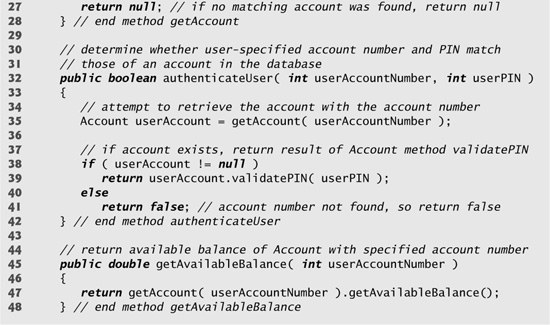
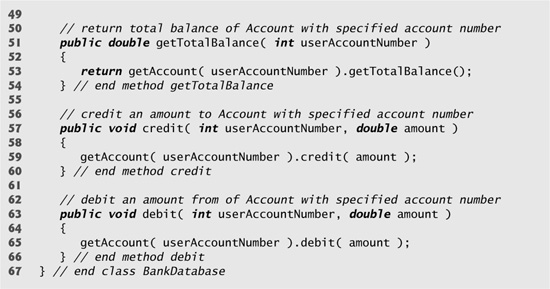
Recall that class BankDatabase serves as an intermediary between class ATM and the actual Account objects that contain a user’s account information. Thus, the methods of class BankDatabase do nothing more than invoke the corresponding methods of the Account object belonging to the current ATM user.
We include private utility method getAccount (lines 17–28) to allow the BankDatabase to obtain a reference to a particular Account within array accounts. To locate the user’s Account, the BankDatabase compares the value returned by method getAccountNumber for each element of accounts to a specified account number until it finds a match. Lines 20–25 traverse the accounts array. If the account number of currentAccount equals the value of parameter accountNumber, the method immediately returns the currentAccount. If no account has the given account number, then line 27 returns null.
Method authenticateUser (lines 32–42) proves or disproves the identity of an ATM user. This method takes a user-specified account number and user-specified PIN as arguments and indicates whether they match the account number and PIN of an Account in the database. Line 35 calls method getAccount, which returns either an Account with userAccountNumber as its account number or null to indicate that userAccountNumber is invalid. If getAccount returns an Account object, line 39 returns the boolean value returned by that object’s validatePIN method. Note that BankDatabase’s authenticateUser method does not perform the PIN comparison itself—rather, it forwards userPIN to the Account object’s validatePIN method to do so. The value returned by Account method validatePIN indicates whether the user-specified PIN matches the PIN of the user’s Account, so method authenticateUser simply returns this value to the client of the class (i.e., ATM).
BankDatabase trusts the ATM to invoke method authenticateUser and receive a return value of true before allowing the user to perform transactions. BankDatabase also trusts that each Transaction object created by the ATM contains the valid account number of the current authenticated user and that this is the account number passed to the remaining BankDatabase methods as argument userAccountNumber. Methods getAvailableBalance (lines 45–48), getTotalBalance (lines 51–54), credit (lines 57–60) and debit (lines 63–66) therefore simply retrieve the user’s Account object with utility method getAccount, then invoke the appropriate Account method on that object. We know that the calls to getAccount within these methods will never return null, because userAccountNumber must refer to an existing Account. Note that getAvailableBalance and getTotalBalance return the values returned by the corresponding Account methods. Also note that credit and debit simply redirect parameter amount to the Account methods they invoke.
H.9 Class Transaction
Class Transaction (Fig. H.8) is an abstract superclass that represents the notion of an ATM transaction. It contains the common features of subclasses BalanceInquiry, Withdrawal and Deposit. This class expands upon the “skeleton” code first developed in Section 10.8. Line 4 declares this class to be abstract. Lines 6–8 declare the class’s private attributes. Recall from the class diagram of Fig. 10.20 that class Transaction contains an attribute accountNumber (line 6) that indicates the account involved in the Transaction. We derive attributes screen (line 7) and bankDatabase (line 8) from class Transaction’s associations modeled in Fig. 10.19—all transactions require access to the ATM’s screen and the bank’s database.
Fig. H.8. Abstract superclass Transaction represents an ATM transaction.
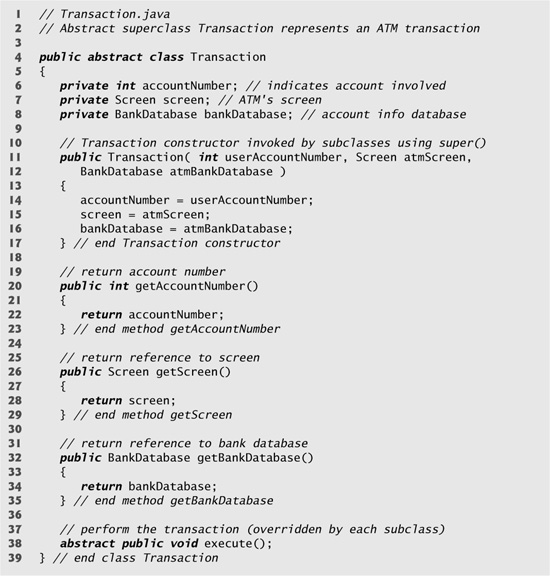
Class Transaction has a constructor (lines 11–17) that takes the current user’s account number and references to the ATM’s screen and the bank’s database as arguments. Because Transaction is an abstract class, this constructor will never be called directly to instantiate Transaction objects. Instead, the constructors of the Transaction subclasses will use super to invoke this constructor.
Class Transaction has three public get methods—getAccountNumber (lines 20–23), getScreen (lines 26–29) and getBankDatabase (lines 32–35). Transaction subclasses inherit these methods from Transaction and use them to gain access to class Transaction’s private attributes.
Class Transaction also declares an abstract method execute (line 38). It does not make sense to provide an implementation for this method, because a generic transaction cannot be executed. Thus, we declare this method to be abstract and force each Transaction subclass to provide its own concrete implementation that executes that particular type of transaction.
H.10 Class BalanceInquiry
Class BalanceInquiry (Fig. H.9) extends Transaction and represents a balance inquiry ATM transaction. BalanceInquiry does not have any attributes of its own, but it inherits Transaction attributes accountNumber, screen and bankDatabase, which are accessible through Transaction’s public get methods. The BalanceInquiry constructor takes arguments corresponding to these attributes and simply forwards them to Transaction’s constructor using super (line 10).
Fig. H.9. Class BalanceInquiry represents a balance inquiry ATM transaction.

Class BalanceInquiry overrides Transaction’s abstract method execute to provide a concrete implementation (lines 14–35) that performs the steps involved in a balance inquiry. Lines 17–18 get references to the bank database and the ATM’s screen by invoking methods inherited from superclass Transaction. Lines 21–22 retrieve the available balance of the account involved by invoking method getAvailableBalance of bankDatabase. Note that line 22 uses inherited method getAccountNumber to get the account number of the current user, which it then passes to getAvailableBalance. Lines 25–26 retrieve the total balance of the current user’s account. Lines 29–34 display the balance information on the ATM’s screen. Recall that displayDollarAmount takes a double argument and outputs it to the screen formatted as a dollar amount. For example, if a user’s availableBalance is 1000.5, line 31 outputs $1,000.50. Note that line 34 inserts a blank line of output to separate the balance information from subsequent output (i.e., the main menu repeated by class ATM after executing the BalanceInquiry).
H.11 Class Withdrawal
Class Withdrawal (Fig. H.10) extends Transaction and represents a withdrawal ATM transaction. This class expands upon the “skeleton” code for this class developed in Fig. 10.22. Recall from the class diagram of Fig. 10.19 that class Withdrawal has one attribute, amount, which line 6 implements as an int field. Figure 10.19 models associations between class Withdrawal and classes Keypad and CashDispenser, for which lines 7–8 implement reference-type attributes keypad and cashDispenser, respectively. Line 11 declares a constant corresponding to the cancel menu option. We’ll soon discuss how the class uses this constant.
Fig. H.10. Class Withdrawal represents a withdrawal ATM transaction.

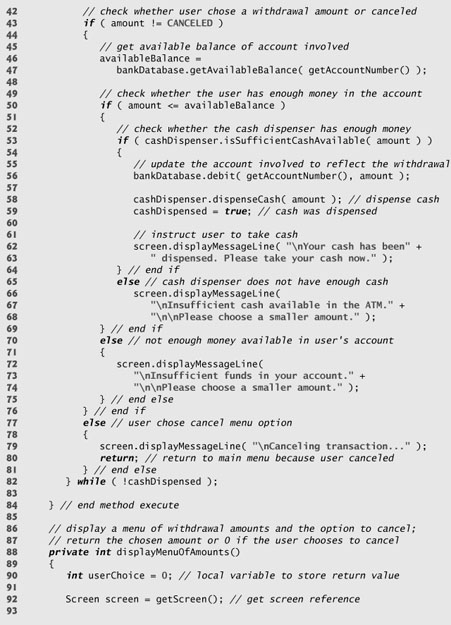

Class Withdrawal’s constructor (lines 14–24) has five parameters. It uses super to pass parameters userAccountNumber, atmScreen and atmBankDatabase to superclass Transaction’s constructor to set the attributes that Withdrawal inherits from Transaction. The constructor also takes references atmKeypad and atmCashDispenser as parameters and assigns them to reference-type attributes keypad and cashDispenser.
Class Withdrawal overrides Transaction’s abstract method execute with a concrete implementation (lines 27–84) that performs the steps involved in a withdrawal. Line 29 declares and initializes a local boolean variable cashDispensed. This variable indicates whether cash has been dispensed (i.e., whether the transaction has completed successfully) and is initially false. Line 30 declares local double variable availableBalance, which will store the user’s available balance during a withdrawal transaction. Lines 33–34 get references to the bank database and the ATM’s screen by invoking methods inherited from superclass Transaction.
Lines 37–82 contain a do... while statement that executes its body until cash is dispensed (i.e., until cashDispensed becomes true) or until the user chooses to cancel (in which case, the loop terminates). We use this loop to continuously return the user to the start of the transaction if an error occurs (i.e., the requested withdrawal amount is greater than the user’s available balance or greater than the amount of cash in the cash dispenser). Line 40 displays a menu of withdrawal amounts and obtains a user selection by calling private utility method displayMenuOfAmounts (declared in lines 88–132). This method displays the menu of amounts and returns either an int withdrawal amount or an int constant CANCELED to indicate that the user has chosen to cancel the transaction.
Method displayMenuOfAmounts (lines 88–132) first declares local variable userChoice (initially 0) to store the value that the method will return (line 90). Line 92 gets a reference to the screen by calling method getScreen inherited from superclass Transaction. Line 95 declares an integer array of withdrawal amounts that correspond to the amounts displayed in the withdrawal menu. We ignore the first element in the array (index 0) because the menu has no option 0. The while statement at lines 98–129 repeats until userChoice takes on a value other than 0. We’ll see shortly that this occurs when the user makes a valid selection from the menu. Lines 101–108 display the withdrawal menu on the screen and prompt the user to enter a choice. Line 110 obtains integer input through the keypad. The switch statement at lines 113–128 determines how to proceed based on the user’s input. If the user selects a number between 1 and 5, line 120 sets userChoice to the value of the element in amounts at index input. For example, if the user enters 3 to withdraw $60, line 120 sets userChoice to the value of amounts[ 3 ] (i.e., 60). Line 120 terminates the switch. Variable userChoice no longer equals 0, so the while at lines 98–129 terminates and line 131 returns userChoice. If the user selects the cancel menu option, lines 123–124 execute, setting userChoice to CANCELED and causing the method to return this value. If the user does not enter a valid menu selection, lines 126–127 display an error message and the user is returned to the withdrawal menu.
The if statement at line 43 in method execute determines whether the user has selected a withdrawal amount or chosen to cancel. If the user cancels, lines 79–80 execute and display an appropriate message to the user before returning control to the calling method (i.e., ATM method performTransactions). If the user has chosen a withdrawal amount, lines 46–47 retrieve the available balance of the current user’s Account and store it in variable availableBalance. Next, the if statement at line 50 determines whether the selected amount is less than or equal to the user’s available balance. If it is not, lines 72–74 display an appropriate error message. Control then continues to the end of the do... while, and the loop repeats because cashDispensed is still false. If the user’s balance is high enough, the if statement at line 53 determines whether the cash dispenser has enough money to satisfy the withdrawal request by invoking the cashDispenser’s isSufficientCashAvailable method. If this method returns false, lines 66–68 display an appropriate error message and the do... while repeats. If sufficient cash is available, then the requirements for the withdrawal are satisfied, and line 56 debits amount from the user’s account in the database. Lines 58–59 then instruct the cash dispenser to dispense the cash to the user and set cashDispensed to true. Finally, lines 62–63 display a message to the user that cash has been dispensed. Because cashDispensed is now true, control continues after the do... while. No additional statements appear below the loop, so the method returns control to class ATM.
H.12 Class Deposit
Class Deposit (Fig. H.11) extends Transaction and represents a deposit ATM transaction. Recall from the class diagram of Fig. 10.20 that class Deposit has one attribute amount, which line 6 implements as an int field. Lines 7–8 create reference-type attributes keypad and depositSlot that implement the associations between class Deposit and classes Keypad and DepositSlot modeled in Fig. 10.19. Line 9 declares a constant CANCELED that corresponds to the value a user enters to cancel. We’ll soon discuss how the class uses this constant.
Fig. H.11. Class Deposit represents a deposit ATM transaction.



Like class Withdrawal, class Deposit contains a constructor (lines 12–22) that passes three parameters to superclass Transaction’s constructor using super. The constructor also has parameters atmKeypad and atmDepositSlot, which it assigns to corresponding attributes (lines 20–21).
Method execute (lines 25–65) overrides abstract method execute in superclass Transaction with a concrete implementation that performs the steps required in a deposit transaction. Lines 27–28 get references to the database and the screen. Line 30 prompts the user to enter a deposit amount by invoking private utility method promptForDepositAmount (declared in lines 68–84) and sets attribute amount to the value returned. Method promptForDepositAmount asks the user to enter a deposit amount as an integer number of cents (because the ATM’s keypad does not contain a decimal point; this is consistent with many real ATMs) and returns the double value representing the dollar amount to be deposited.
Line 70 in method promptForDepositAmount gets a reference to the ATM’s screen. Lines 73–74 display a message on the screen asking the user to input a deposit amount as a number of cents or “0” to cancel the transaction. Line 75 receives the user’s input from the keypad. The if statement at lines 78–83 determines whether the user has entered a real deposit amount or chosen to cancel. If the user chooses to cancel, line 79 returns the constant CANCELED. Otherwise, line 82 returns the deposit amount after converting from the number of cents to a dollar amount by casting input to a double, then dividing by 100. For example, if the user enters 125 as the number of cents, line 82 returns 125.0 divided by 100, or 1.25—125 cents is $1.25.
The if statement at lines 33–64 in method execute determines whether the user has chosen to cancel the transaction instead of entering a deposit amount. If the user cancels, line 63 displays an appropriate message, and the method returns. If the user enters a deposit amount, lines 36–39 instruct the user to insert a deposit envelope with the correct amount. Recall that Screen method displayDollarAmount outputs a double formatted as a dollar amount.
Line 42 sets a local boolean variable to the value returned by depositSlot’s isEnvelopeReceived method, indicating whether a deposit envelope has been received. Recall that we coded method isEnvelopeReceived (lines 8–11 of Fig. H.5) to always return true, because we are simulating the functionality of the deposit slot and assume that the user always inserts an envelope. However, we code method execute of class Deposit to test for the possibility that the user does not insert an envelope—good software engineering demands that programs account for all possible return values. Thus, class Deposit is prepared for future versions of isEnvelopeReceived that could return false. Lines 47–53 execute if the deposit slot receives an envelope. Lines 47–50 display an appropriate message to the user. Line 53 then credits the deposit amount to the user’s account in the database. Lines 57–58 will execute if the deposit slot does not receive a deposit envelope. In this case, we display a message to the user stating that the ATM has canceled the transaction. The method then returns without modifying the user’s account.
H.13 Class ATMCaseStudy
Class ATMCaseStudy (Fig. H.12) is a simple class that allows us to start, or “turn on,” the ATM and test the implementation of our ATM system model. Class ATMCaseStudy’s main method (lines 7–11) does nothing more than instantiate a new ATM object named theATM (line 9) and invoke its run method (line 10) to start the ATM.
Fig. H.12. ATMCaseStudy.java starts the ATM.
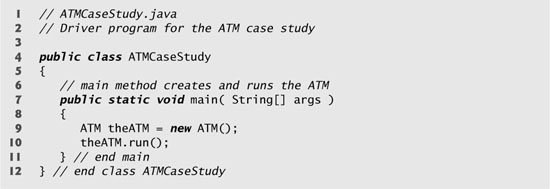
H.14 Wrap-Up
Congratulations on completing the entire software engineering ATM case study! We hope you found this experience to be valuable and that it reinforced many of the concepts that you learned in Chapters 1–10. We would sincerely appreciate your comments, criticisms and suggestions. You can reach us at [email protected]. We’ll respond promptly.


